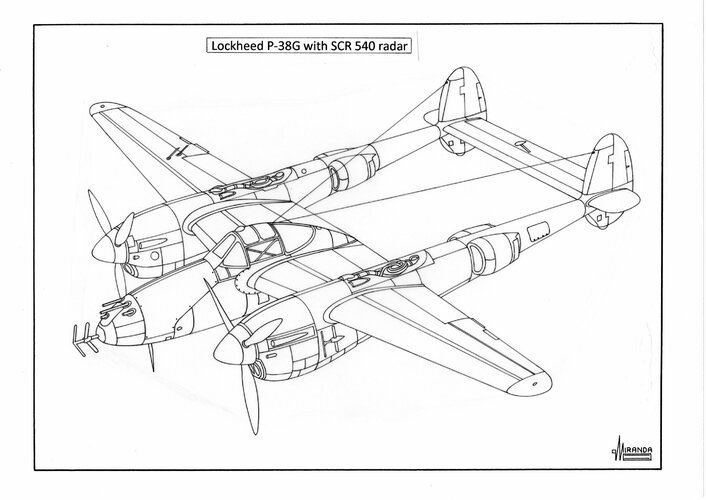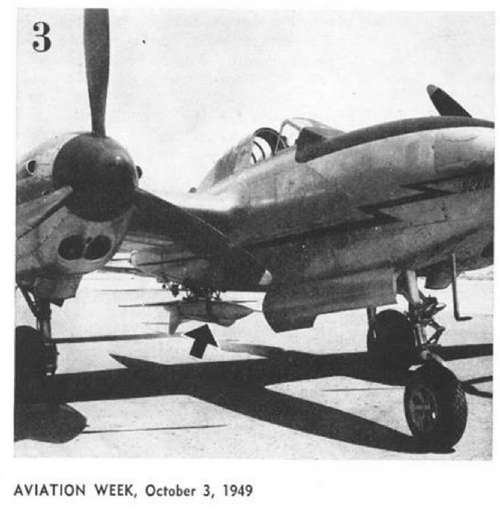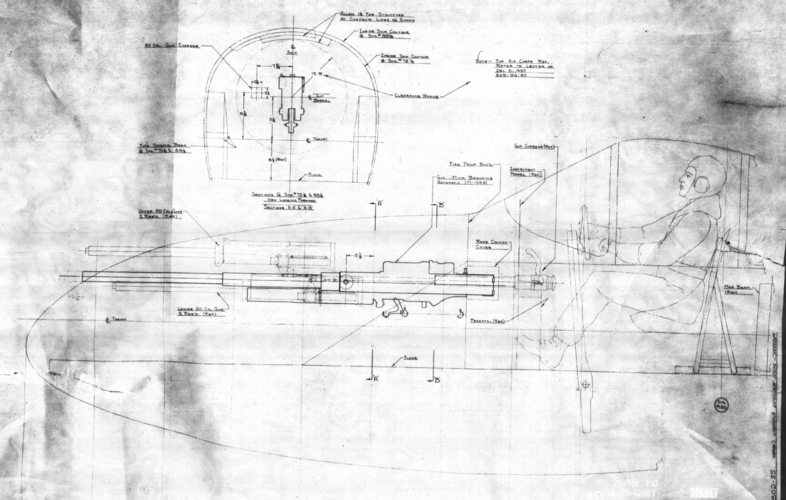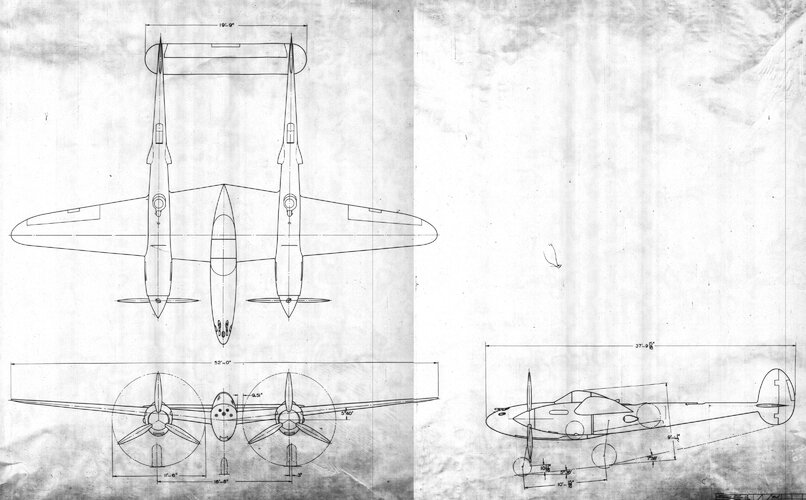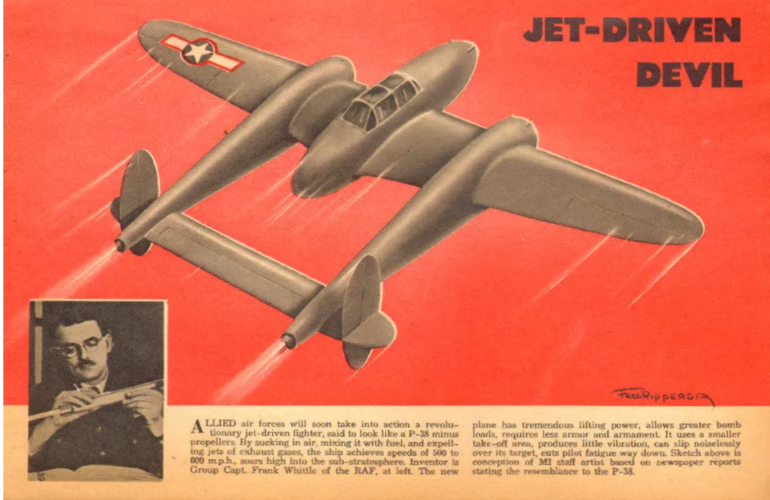@TomcatViP Im not sure if I get it right what you mean, generally turbochargers are more fuel efficient than mecanical driven superchargers (especially in great hight an at slow speed), but, as you said they need more room, weight and cooling air than mecanical driven chargers.
You are using an out of date browser. It may not display this or other websites correctly.
You should upgrade or use an alternative browser.
You should upgrade or use an alternative browser.
Lockheed P-38 test planes and planned developments
- Thread starter GTX
- Start date
- Joined
- 13 June 2007
- Messages
- 2,173
- Reaction score
- 3,087
And there was a need to have different engines/engine manufacturers, not everyone just making Merlins. The Allison was well established in the U.S. before the RR Merlin came along and was produced here by Packard. The Allison was a great engine in and of itself but tended to be maligned in concert with some of the airframes that used it - P-39 and P-40 come to mind and to some extent, the P-38 as well. There is a book out there by Warren Bodie that does a nice job of telling the tale of the Lightning, the good, the bad and the story as whole.Turbo also offers better performances at a much larger range of altitude. Superchargers are point design and hence will offer a peak value that then is altered more or less quickly.
The advantages lie obviously in their lesser fuel consumption, what makes the overall system of a supercharged fighter more efficient as more compact and then less heavy (in complement to what as already been said above, fuel tanks in aviation are also bulky and volume impacts directly the airframe weight and performances).
Enjoy the Day! Mark
T. A. Gardner
ACCESS: Top Secret
- Joined
- 18 February 2021
- Messages
- 1,146
- Reaction score
- 2,007
It's interesting to note that Allison wasn't unaware of the need for a two-stage supercharger on their engine and put a sort of one on the V1710-119 and later versions. This didn't have an intercooler but was variable speed with altitude and did work--well, some of the time.
The biggest drawback was the arrangement was a tack-on to the single stage supercharger to minimize the changes to the engine. When it worked, it worked well. But the set up was unreliable on the whole.
The biggest drawback was the arrangement was a tack-on to the single stage supercharger to minimize the changes to the engine. When it worked, it worked well. But the set up was unreliable on the whole.
Lockheed P-38 night fighters
In February 1943 the 6th NFS (Detachment “B”) equipped with six Douglas P-70 A-1 night fighters, arrived Henderson Field-Guadalcanal.
In June the decision was made to replace the Nighthawks with some P-38 J and P-38 G day fighters to compensate for the P-70’s inadequacies.
At the end of August these Lightnings had shot down four Japanese aircraft with the help of ground searchlights directed by an SCR 268 air warning radar.
To meet the need for a high-performance night interceptor, as a stop gap measure, in summer 1943 two P-38 Gs were modified with the installation of SCR 540 air interception radar sets taken from the P-70s.
The radar equipment, along with the HF and VHF radios, was mounted in one drop tank.
The Yagi transmitting director dipole was mounted in the nose and the two azimuth receiving dipoles were installed in the engine cowlings. Two of the M2 machine guns and their ammunition boxes had to be moved forward. Four slanted-rods antennae, for elevation receiving, were mounted above and below of the port wing.
Both fighters were painted overall Dull Black 44.
In March 1943 the 6th NFS (Detachment “A”) equipped with five Douglas P-70 A-1 night fighters and some P-38 H day fighters, arrived Port-Moresby-New Guinea.
In November the 418th NFS arrived Dobodura-New Guinea and the 419th NFS arrived Guadalcanal. Each squadron was assigned a small number of P-38J, G and H day, fighters with no radar or any other night equipment, except one sheet of red cellophane covering the gunsight light.
On December 10, the 419th began to carry out night interceptions with the help of searchlights. Ground control interception (GCI) radar SCR 584 (10-cm) was later installed.
In Saipan two B-24s of the 27th BG were equipped with GCI airborne radars to vector the P-38s but the system did not pass the experimental phase.
In February 1944 the 418th NFS, based at Dobodura, received the two P-38 G night fighters modified with SCR 540 AI radar and some P-38 H day fighters that were used to carry night harassment raids on Rabaul. On June 15, 1944 the squadron began operating from Morotai.
Between September 15, 1944 and February 1, 1945 the Wama Drome-Morotai Allied air base suffered 82 raids conducted by the Japanese 7th Air Division. A typical IJN raid force consisted of a dozen Mitsubishi G4M2a Model 24 Betty bombers but the P-61 night fighters lacked the speed to intercept these fast high-altitude bombers that used water-injection boosted engines.
In November 1944 the 418th NFS began to carry out night interceptions flying at 5,000 ft. above the antiaircraft gun fire, with its shell fused at 20,000 ft.
If searchlights illuminated the enemy bomber, the ground fire stopped and fighters orbiting outside the ring of antiaircraft fire, waiting for orders from the GCI, started the attack.
The Black Widow was not well suited to the procedure and the 418th preferred to use some P-38s which were later replaced by Australian Spitfires.
When the Japanese began to use chaff to make radar location difficult, the AAF combined their SCR 527 and SCR 270 early warning equipment with the AN/APS-10 for GCI. This radar was immune to interference from the window system because it operated in 3-cm wavelength.
In April 1944, two P-38Js (44-23544 and 44-23549) from 547th NFS based at Lingayen-Philippines, were modified with the installation of AN/APS-4 AI radar sets housed in cylindrical pods under the starboard wing.
In December 1944 the P-38L-5-LO s/n 44-26865 was modified as P-38 M night fighter with one AN/APS-4 AI radar mounted under the nose in an external, a second cockpit for the radar operator, AN/APN-1 radio altimeter and nose guns with flash hiders.
The aircraft was painted overall Gloss Black and during flight tests demonstrated better performances than the P-61.
USAAF ordered 75 conversions to Lockheed Dallas Modification Center but only four units arrived to Philippines and one to India before the war ended.
In late 1945 the 418th NFS equipped with P-38 M night fighters arrived to Atsugi-Japan with the Occupation Forces.
Lockheed P-38 M - Technical Data
Wingspan: 52 ft. (15.85 m); length: 37.8 ft. (11.53 m); height: 10.3 ft. (3.15 m); wing area: 328 sq. ft. (30.4 sq. m); max weight: 17,646 lb. (8,000 kg); max speed: 391 mph (629 km/h); service ceiling: 44,000 ft. (13,410 m.); power plant: two Allison V-1710-110 (111) twelve-cylinder Vee liquid cooled engines, each rated at 1,475 hp. for take-off and 1,600 hp. in “war emergency” power at 28,700 ft.; armament: one 20-mm Hispano M2 cannon and four nose mounted 0.50-in M2 Browning heavy machine guns.
Bibliography
Books
Ethell, J., Lockheed P-38 Lightning, Jane’s Aircraft Spectacular, 1983.
Angelucci, E., The American Fighter, Orion, 1987.
Green, W., The Complete Book of Fighters, Salamander, 2001.
Green, W., War Planes of the Second World War-Fighters-Volume Four, Macdonald, 1961.
Bodie, W., The Lockheed P-38 Lightning, Widewing, 1991.
Pape, G., Queen of the Midnight Skies, Schiffer, 1992.
Davis, L., P-38 Walk Around, Number 5530, Squadron/Signal, 2003.
Davis, L., P-38 in action, Number 1025, Squadron/Signal, 1976.
Davis, L., P-38 in action, Number 1109, Squadron/Signal, 1990.
Doyle, D., P-38 in action, Number 1222, Squadron/Signal, 2011.
Kinzey, B., P-38 Lightning, In Detail & Scale Vol. 57 and 58, 1998.
O'Leary, M., P-38 Lightning, Production Line to Front Line, Osprey, 1999.
Publications
“P-38 Lightning”, Wings Magazine, Vol.8, Nº4, August 1978.
“Modeller’s Guide of the P-38 Lightning”, by Jay Sherlock.
“Operational Equipment for P-28D through P-38 G Series Airplanes”, Technical Order T.O. No.01-75F-1, Section IV.
“Lockheed P-38 Lightning”, Aero Detail 28, Dainippon Kaiga, 2000.
Attachments
I wasn't aware that the Allison hydraulic auxiliary supercharger was unreliable, and it did, in fact, have an intercooler. My source (Vee's for Victory) indicates that its main disadvantage was that it significantly lengthened the engine installation and thus couldn't be retrofitted into aircraft not designed for it.It's interesting to note that Allison wasn't unaware of the need for a two-stage supercharger on their engine and put a sort of one on the V1710-119 and later versions. This didn't have an intercooler but was variable speed with altitude and did work--well, some of the time.
The biggest drawback was the arrangement was a tack-on to the single stage supercharger to minimize the changes to the engine. When it worked, it worked well. But the set up was unreliable on the whole.
The Allisons on the P-63 used this supercharger, as did the late-model P-82s. Some of these engines made well over 2000 hp. An experimental turbocompound made 3000.
Allison also designed an improved, gear-driven solution in-house, without USAAF support. This points to the main reason why Allison never deployed a good mechanical unit: the customer was not interested. The USAAF put all its faith in turbosuperchargers.
T. A. Gardner
ACCESS: Top Secret
- Joined
- 18 February 2021
- Messages
- 1,146
- Reaction score
- 2,007
I wasn't aware that the Allison hydraulic auxiliary supercharger was unreliable, and it did, in fact, have an intercooler. My source (Vee's for Victory) indicates that its main disadvantage was that it significantly lengthened the engine installation and thus couldn't be retrofitted into aircraft not designed for it.It's interesting to note that Allison wasn't unaware of the need for a two-stage supercharger on their engine and put a sort of one on the V1710-119 and later versions. This didn't have an intercooler but was variable speed with altitude and did work--well, some of the time.
The biggest drawback was the arrangement was a tack-on to the single stage supercharger to minimize the changes to the engine. When it worked, it worked well. But the set up was unreliable on the whole.
The Allisons on the P-63 used this supercharger, as did the late-model P-82s. Some of these engines made well over 2000 hp. An experimental turbocompound made 3000.
Allison also designed an improved, gear-driven solution in-house, without USAAF support. This points to the main reason why Allison never deployed a good mechanical unit: the customer was not interested. The USAAF put all its faith in turbosuperchargers.
The V-1710 has often been criticized for not having a "high-altitude" supercharger. The comparison is usually to the later, two-stage, versions of the Rolls-Royce Merlin built by Packard as the V-1650 and used in the P-51B Mustang and subsequent variants. The US Army had specified that the V-1710 was to be a single-stage supercharged engine and, if a higher altitude capability was desired, the aircraft could use their newly developed turbosupercharger as was featured in the P-37, P-38, and XP-39.
The benefits of a two-stage supercharger eventually became so clear that Allison did make some efforts in this direction. Allison attached an auxiliary supercharger in various configurations to the existing engine-mounted supercharger and carburetor. Early versions of these two-stage supercharger engines were used on the P-63. No intercooler, aftercooler, or backfire screen were incorporated into these two-stage V-1710 engines (except for the V-1710-119 used on the experimental P-51J, which had an aftercooler). The two-stage Merlin engines had all of these features, which were designed to prevent detonation from charge heating and backfire into the supercharger. The G-series V-1710s installed on the F-82 E/F/G models had only anti-detonation injection to deal with these problems, and not surprisingly had severe reliability and maintenance problems. In one record, it was stated that the F-82 required 33 hours of maintenance for one hour of flight.
Aviation Powerplants - A Warbirds Resource Group Site
The Powerplant Resource Center is a database of aircraft engines used during World War II.
The two-stage supercharger set up was notorious for its unreliability. It soldiered on in many USAF aircraft in the immediate postwar years because RR wanted far larger royalty payments for continued production of the Merlin engine forcing the USAF to end its use.
- Joined
- 19 July 2016
- Messages
- 4,270
- Reaction score
- 3,454
Nose, meet face. Enough said?
As the Philippines wasn't invaded by U.S. forces until October 1944, this must refer to April 1945.
In April 1944, two P-38Js (44-23544 and 44-23549) from 547th NFS based at Lingayen-Philippines, were modified with the installation of AN/APS-4 AI radar sets housed in cylindrical pods under the starboard wing.
The late G-series engine installations in the F-82 did have reliability problems. By then the engine was no longer a development priority. Problems that could have been worked out weren't--only about 700 units were were produced, after all. It probably did not help that the G-series engines had war emergency ratings of something like 2300 hp. Unlike the A planned intercooler and direct fuel injection might have solved the reliability issues, even so. But the turbojet was the future, and Allison was already cutting over to the new technology.I wasn't aware that the Allison hydraulic auxiliary supercharger was unreliable, and it did, in fact, have an intercooler. My source (Vee's for Victory) indicates that its main disadvantage was that it significantly lengthened the engine installation and thus couldn't be retrofitted into aircraft not designed for it.It's interesting to note that Allison wasn't unaware of the need for a two-stage supercharger on their engine and put a sort of one on the V1710-119 and later versions. This didn't have an intercooler but was variable speed with altitude and did work--well, some of the time.
The biggest drawback was the arrangement was a tack-on to the single stage supercharger to minimize the changes to the engine. When it worked, it worked well. But the set up was unreliable on the whole.
The Allisons on the P-63 used this supercharger, as did the late-model P-82s. Some of these engines made well over 2000 hp. An experimental turbocompound made 3000.
Allison also designed an improved, gear-driven solution in-house, without USAAF support. This points to the main reason why Allison never deployed a good mechanical unit: the customer was not interested. The USAAF put all its faith in turbosuperchargers.
The V-1710 has often been criticized for not having a "high-altitude" supercharger. The comparison is usually to the later, two-stage, versions of the Rolls-Royce Merlin built by Packard as the V-1650 and used in the P-51B Mustang and subsequent variants. The US Army had specified that the V-1710 was to be a single-stage supercharged engine and, if a higher altitude capability was desired, the aircraft could use their newly developed turbosupercharger as was featured in the P-37, P-38, and XP-39.
The benefits of a two-stage supercharger eventually became so clear that Allison did make some efforts in this direction. Allison attached an auxiliary supercharger in various configurations to the existing engine-mounted supercharger and carburetor. Early versions of these two-stage supercharger engines were used on the P-63. No intercooler, aftercooler, or backfire screen were incorporated into these two-stage V-1710 engines (except for the V-1710-119 used on the experimental P-51J, which had an aftercooler). The two-stage Merlin engines had all of these features, which were designed to prevent detonation from charge heating and backfire into the supercharger. The G-series V-1710s installed on the F-82 E/F/G models had only anti-detonation injection to deal with these problems, and not surprisingly had severe reliability and maintenance problems. In one record, it was stated that the F-82 required 33 hours of maintenance for one hour of flight.Aviation Powerplants - A Warbirds Resource Group Site
The Powerplant Resource Center is a database of aircraft engines used during World War II.powerplants.warbirdsresourcegroup.org
The two-stage supercharger set up was notorious for its unreliability. It soldiered on in many USAF aircraft in the immediate postwar years because RR wanted far larger royalty payments for continued production of the Merlin engine forcing the USAF to end its use.
By comparison, something like 5000 two-stage supercharged, E-series V-1710s were produced for P-63s. As near as I know, they had none of the problems of these later units--and maybe fewer problems overall than the turbocharged Allisons did.
The auxiliary stage intercooler was, in fact, designed with an intercooler, and experimental V-1710s and V-3420s incorporated one. But production engines did not, probably because the extra complexity was not considered necessary, given the ADI, the design of the supercharger, and war-time exigencies. From the first, Allison prioritized modularity, component interchangeability, and mass production. So everything included had to both earn its place and do nothing to disrupt the assembly line.
The auxiliary stage supercharger is a case in point. It was designed rapidly to address the shortcomings of the USAAF's pre-war, turbo-only policy. It provided turbocharger levels of performance in a modular, bolt-on unit that could be attached to any Allison model. The infinitely variable hydraulic drive was selected both to eliminate the shock loads, vibrations, and long development time that come with gear-drive and, just as importantly, to minimize the charge heating caused by turbochargers and geared superchargers. The design included an automatic engine control system to protect the engine by managing boost and ADI with changes in altitude and in engine and propeller RPM. Generally it seems to have worked very well.
Primary source: Daniel D. Whitney, Vee's for Victory! The Story of the Allison V-1710 Aircraft Engine, 1929-1948 (Schiffer, 1998)
T. A. Gardner
ACCESS: Top Secret
- Joined
- 18 February 2021
- Messages
- 1,146
- Reaction score
- 2,007
I agree, that with time Allison could have worked out the issues. But they were already more focused on jet engines, just like every other aircraft engine manufacturer was. Piston engines in 1945 were at a dead end for military aircraft use.
The very act of compressing the air heats it, having the auxiliary stage supercharger hydraulically driven is going to make no difference to that simple fact. Dan's book is good, but he's loath to admit that the V-1710 had issues in several areas."to minimize the charge heating caused by turbochargers and geared superchargers"
It does make a difference whenever the actual pressure ratio of a stage is below the maximum. If throtteling is used for pressure regulation, the charger will allways run with a constant compression ratio and maximum compression end temperature. With a variable hydraulic drive system, the pressure ratio is lowered by reducing the rpm, so that the compression end temperature is lower as long as the charger is not operating below the maximum pressure ratio.
Colonial-Marine
UAVs are now friend, drones are the real enemy.
- Joined
- 5 October 2009
- Messages
- 1,468
- Reaction score
- 1,323
Is there any more information on the "six-shooter" P-38 nose with the two 20mm cannons? Seems like it would have been a potent increase in firepower.
Scott Kenny
ACCESS: USAP
- Joined
- 15 May 2023
- Messages
- 11,553
- Reaction score
- 14,157
Superchargers also produce more boost immediately, no waiting for turbos to spool up.Turbo also offers better performances at a much larger range of altitude. Superchargers are point design and hence will offer a peak value that then is altered more or less quickly.
The advantages lie obviously in their lesser fuel consumption, what makes the overall system of a supercharged fighter more efficient as more compact and then less heavy (in complement to what as already been said above, fuel tanks in aviation are also bulky and volume impacts directly the airframe weight and performances).
And for fighters or anything landing on carriers, having more power NOW is vital.
Scott Kenny
ACCESS: USAP
- Joined
- 15 May 2023
- Messages
- 11,553
- Reaction score
- 14,157
Definitely an early plan. Look at how small the radiator and intercooler scoops are.No details on this as the title block is mostly empty. This looks pretty early - note the odd annular intake aft of the spinner
View attachment 716772
- Joined
- 22 January 2006
- Messages
- 4,212
- Reaction score
- 2,007
Is it possible to know the source?No details on this as the title block is mostly empty
Thanks
- Joined
- 8 March 2009
- Messages
- 1,055
- Reaction score
- 1,293
Traunch of Lockheed microficheIs it possible to know the source?
Thanks
Sorry for a late replyTurbo also offers better performances at a much larger range of altitude. Superchargers are point design and hence will offer a peak value that then is altered more or less quickly.
The advantages lie obviously in their lesser fuel consumption, what makes the overall system of a supercharged fighter more efficient as more compact and then less heavy (in complement to what as already been said above, fuel tanks in aviation are also bulky and volume impacts directly the airframe weight and performances).
Aero engines of the day, that have the engine-stage S/C as-is (ie. all ww2 1st line aero engines) that also have a turbocharger added to help out at high altitudes ( like it was the case with what P-47, P-38 or the B-17 had) will indeed outperform the similar engines that are without the turbo support. Having the turbo 'support' meant that engines have two stages of supercharging - 1st stage is the turbocharger, 2nd stage is the integral (a.k.a. 'engine stage') S/C.
Obviously, an engine with the gear-driven 2-stage S/Ced engine will have both stages powered by engine itself (doh).
Price to pay is indeed greater bulk required, especially since the metalurgy of the day required that turboes are better located a bit away from the engine itself lest the turbine(s) will overheat, with severe problem arising; that adds to the drag and weight - both affect performance negatively.
Chances for a turbo to be retrofitted on an existing fighter in a streamlined fashion were low, unlike when people were retrofitting the 2-stage S/Ced engines on fighters that were designed around the 1-stage S/Ced engines.
Price is also that there is almost no benefit wrt. to the exhaust thrust (can equal to 12-15% of bhp the engine delivers to the prop at higher altitudes) and to the usage of ram effect (well-designed ram air intakes of the day were increasing the rated altitudes on fast aircraft by 4000-5000 ft, depending on aircraft; 'turboed' A/C benefitted by some 1500-3000 ft).
So while in theory a turbo will make more power at high altitudes than a 2-stage supercharged engine, in reality the benefits were negligible, despite all the hoops required for the turbo to work.
Fuel consumption on same power settings was perhaps 5% better for the turboed engines of the same power as the 2-stage engines (comparing the P-38L table with that of the P-51B) - can that really negate the effects of increase in bulk and drag of the turbo installation?
And there was a need to have different engines/engine manufacturers, not everyone just making Merlins. The Allison was well established in the U.S. before the RR Merlin came along and was produced here by Packard. The Allison was a great engine in and of itself but tended to be maligned in concert with some of the airframes that used it - P-39 and P-40 come to mind and to some extent, the P-38 as well. There is a book out there by Warren Bodie that does a nice job of telling the tale of the Lightning, the good, the bad and the story as whole.
Enjoy the Day! Mark
Alliosn as a company was well-established in the US, but V-1710 have had it's host of problems in 1940-41, that for example led to the restriction on rpm and boost (= power) the engines were allowed to do. AAF reckoned that putting all of it's eggs in the V-1710 basket was a mistake, thus opening the path to the P-47B (R-2800) and Merlin-powered fighters, initially the P-40F.
I'd wager to say that Achilles' heel of both the P-40 and P-39, as the war was dragging on, was the V-1710, since the versions available (and used) were lagging behind even the 1-stage Merlin by some 2 years, and same when compared with the best Axis engines.
V-1710 on the P-39s and P-40s was better at lower altitudes than the engines the Axis had, and was more reliable than the German engines.
Superchargers also produce more boost immediately, no waiting for turbos to spool up.
And for fighters or anything landing on carriers, having more power NOW is vital.
At low altitudes, the engine-stage S/C is making most of the boost anyway.
At high altitudes, turbo is spooled up since waste gates are mostly closed, and best part of exhaust is directed to the turbine.
Turboes on the 99% of the cars equipped so are the only means of supercharging, there is no additional S/C to help out.
- Joined
- 29 January 2008
- Messages
- 916
- Reaction score
- 2,050
I was going to put this on the above thread but it is closed. Not sure if this is the proper place for this so mods can move as needed. I found the attched on the web, no info on it other than it came out of a 1944 magazine (descripitiion in picture states its a conjected drawing by the MI staff, not sure what publication this is).
Attachments
Scott Kenny
ACCESS: USAP
- Joined
- 15 May 2023
- Messages
- 11,553
- Reaction score
- 14,157
I wouldn't be surprised if someone discussed the idea. I'd want a couple of axial-flow jets, not the big fat centrifugal flow jets used early on. Much of the inside of a Lightning's tail booms is hollow, or filled with things that the piston engines needed and that would be empty space with jets.
I was going to put this on the above thread but it is closed. Not sure if this is the proper place for this so mods can move as needed. I found the attched on the web, no info on it other than it came out of a 1944 magazine (descripitiion in picture states its a conjected drawing by the MI staff, not sure what publication this is).
It'd probably absolutely kill the range, though.
BlackBat242
OK, I changed my personal text ;)
- Joined
- 10 April 2013
- Messages
- 1,472
- Reaction score
- 4,260
Reading the text with that illustration* tells me they were meaning the DH Vampire ("inventor is Frank Whittle")... the artist simply didn't know it was a single-engine aircraft, so he put the exhausts in the next-logical place.
I was going to put this on the above thread but it is closed. Not sure if this is the proper place for this so mods can move as needed. I found the attched on the web, no info on it other than it came out of a 1944 magazine (descripitiion in picture states its a conjected drawing by the MI staff, not sure what publication this is).
* "said to look like a P-38 minus propellers" and "based on newspaper reports stating the resemblance to the P-38".
Last edited:
"MI" probably refers to Mechanix Illustrated.
I was going to put this on the above thread but it is closed. Not sure if this is the proper place for this so mods can move as needed. I found the attched on the web, no info on it other than it came out of a 1944 magazine (descripitiion in picture states its a conjected drawing by the MI staff, not sure what publication this is).
- Joined
- 25 July 2007
- Messages
- 4,299
- Reaction score
- 4,193
"MI" probably refers to Mechanix Illustrated.
Makes sense. Artist Fred Ripperda worked for Fawcett Publications, Inc., who put out Mechanix Illustrated.
Mechanix Illustrated 1944-03: Vol 32 Iss 5
Mechanix Illustrated 1944-03: Vol 32 Iss 5 : Free Download, Borrow, and Streaming : Internet Archive
Mechanix Illustrated 1944-03: Volume 32, Issue 5.Digitized from IA1641525-07.Previous issue: sim_todays-homeowner-solutions_1944-02_32_4.Next issue:...
archive.org
Attachments
Hi folks,
Here's another one that made it to at least the mock-up stage: The "six-shooter" with two 20mm cannon instead of the usual single one.
Regards,
Greg
P-38L with 8 .50cal in the nose and 2, 2-gun gun pods under the wings.
T. A. Gardner
ACCESS: Top Secret
- Joined
- 18 February 2021
- Messages
- 1,146
- Reaction score
- 2,007
Sounds like they're trying to describe the DeHavilland Vampire.
I was going to put this on the above thread but it is closed. Not sure if this is the proper place for this so mods can move as needed. I found the attched on the web, no info on it other than it came out of a 1944 magazine (descripitiion in picture states its a conjected drawing by the MI staff, not sure what publication this is).

Similar threads
-
-
-
-
FLIGHTS OF FANTASY: The AWACS Lockheed Viking
- Started by Sentinel Chicken
- Replies: 7
-

